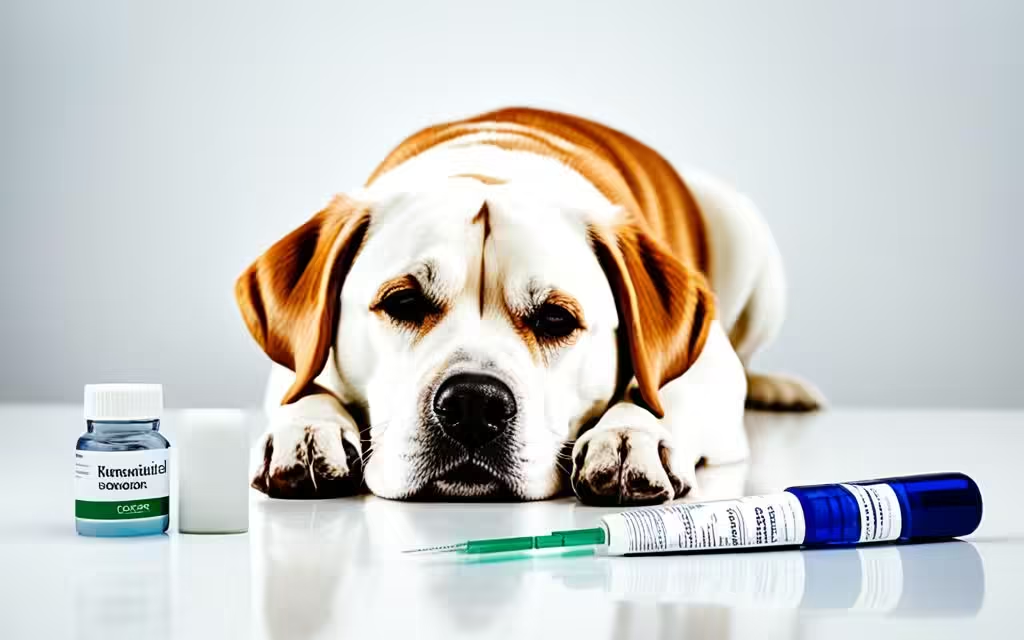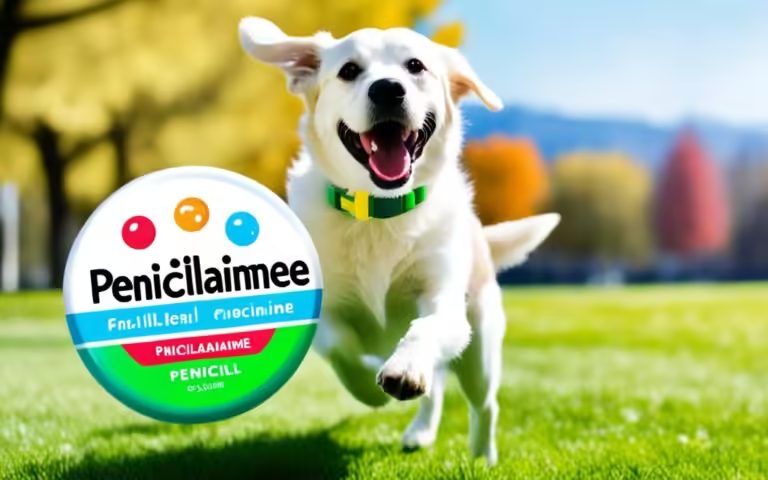Phenobarbital for Dog: Canine Seizure Treatment
Seizures in dogs can be scary and dangerous, happening to about 5% of them1. But, there’s a proven medicine that helps manage these seizures – Phenobarbital. Vets often choose this barbiturate for treating dog epilepsy and seizures1.
Key Takeaways
- Phenobarbital is a top choice for dogs with seizures because it’s safe and affordable.
- Some breeds like Schnauzers, Collies, and Retrievers are more likely to have seizures1.
- Phenobarbital helps by making brain electrical activity more stable, which reduces seizures in dogs.
- It’s important to give Phenobarbital the right amount and way to manage seizures well.
- Checking the levels of Phenobarbital and watching for side effects is key for ongoing treatment.
Table of Contents
Understanding Canine Seizures
Seizures in dogs happen when there’s abnormal electrical activity in the brain2. These sudden events can show as twitching, shaking, or even losing consciousness. It’s important to know the common causes and types of seizures.
Common Causes of Seizures in Dogs
Epilepsy is the top reason for seizures in dogs2. About 0.75% of dogs get epilepsy2. Idiopathic epilepsy, with no known cause, affects dogs aged 1-5 years2. Some dog breeds have a genetic link to epilepsy, like the Lagotto Romagnolo2. Other causes include brain inflammation, cancer, and diseases like liver or kidney issues2.
Seizure Types and Symptoms
Seizures in dogs can be mild or severe, showing as twitching or loss of consciousness3. Some breeds, like German Shepherds, need medicine to manage seizures4. Schnauzers and Collies are more likely to have epilepsy4. Changes in behavior before a seizure can signal epilepsy, including aggression or irritability3. Frequent or long seizures can harm a dog’s brain2.
The International Veterinary Epilepsy Task Force has a seizure classification for dogs, similar to humans2. Reactive seizures, triggered by toxins or metabolic issues, aren’t epilepsy2.
Up to 1 in 20 dogs might have epilepsy3. Border collies often have a short life expectancy after seizures start3. Dogs usually start having seizures between 6 months and 6 years old3. But, some breeds like golden retrievers might get brain tumors at 4 years or older3. Having a seizure can make more seizures more likely, no matter the cause3.
“Approximately 0.75% of the canine population is estimated to be affected by epilepsy.”
What is Phenobarbital?
Phenobarbital is a type of barbiturate used to treat seizures and as a sedative for cats, dogs, ferrets, and horses5. It goes by many names, like phenobarbitone and phenylethylbarbituric acid. You might find it under brand names like Nobatol® or Luminal Sodium®5.
For dogs, phenobarbital is a first-choice medicine for seizures. It can cut down the number, length, and intensity of seizures by up to 85%5. It helps manage seizures from various causes, like epilepsy, meningitis, or brain injuries5.
Dogs can take phenobarbital in different strengths, like 15 mg or 60 mg6. It works well for dogs and cats with seizure disorders, no matter the cause6.
| Phenobarbital Drug Information | Details |
|---|---|
| Uses | Treats seizures and acts as a sedative in cats, dogs, ferrets, and horses |
| Available Tablet Strengths | 15 mg (1/4 grain), 30 mg (1/2 grain), 60 mg (1 grain), and 90 mg (1 and one-half grain) |
| Effectiveness | Can reduce seizure frequency, duration, and severity by up to 85% in some studies |
| Common Causes of Seizures Treated | Idiopathic epilepsy, meningitis, head trauma, or brain tumors |
Phenobarbital is key in managing seizures in pets. Its effectiveness and versatility make it a top choice for vets and pet owners.
“Phenobarbital is generally effective for dogs and cats with seizure disorders, regardless of the underlying cause, such as epilepsy, brain tumors, infectious diseases, or poisonings.”6
How Phenobarbital Works for Dog Seizures
Phenobarbital is a key medicine for dogs with seizures7. It calms down brain activity to stop seizures8. It does this by lowering Glutamate, a nerve stimulant8.
Mode of Action
Phenobarbital quickly gets to the brain when given8. It starts working in 2-4 hours if given by mouth8. It takes 7-14 days to work well, controlling seizures8. This medicine stays in the system for 24 to 72 hours, keeping seizures under control8.
Benefits for Canine Seizure Control
Phenobarbital stops seizures in dogs8. It’s the top choice for dogs, starting at 2-3 mg/kg twice a day7. It can be used alone or with other medicines for better seizure control8.
Checking the medicine levels in the blood is important7. This is done after two weeks, then every three, six months, and yearly for dogs on it long-term7. This keeps the medicine working right and safe6.
| Medication | Typical Dosage | Monitoring Recommendations |
|---|---|---|
| Phenobarbital | 2-3 mg/kg twice daily | Check levels at 2 weeks, 3 months, 6 months, then annually |
| Potassium Bromide (KBr) | 30 mg/kg once daily | Check levels every 3 months, then 6 months, then annually |
| Imepitoin | 10-30 mg/kg twice daily | No specific monitoring recommendations |
| Levetiracetam | Not licensed, but can be used safely | No specific monitoring recommendations |
Phenobarbital makes brain neurons less excitable, stopping seizures in many dogs78. It’s safe and cheaper than other seizure medicines78.
“Phenobarbital is the most commonly used anti-epileptic drug (AED) in dogs.”7
Phenobarbital Dosage for Dogs
The right amount of phenobarbital for dogs depends on their weight, how often and how severe their seizures are, and regular blood tests9. It’s usually given orally every 12 hours, with or without food10. If a dose is missed, don’t try to catch up. Just stick to the usual schedule10.
Dosage Guidelines
Phenobarbital comes in different strengths for dogs, like 15 mg, 30 mg, 60 mg, 90 mg, and 100 mg tablets11. Vets will keep an eye on blood levels to find the best dose10. They’ll check liver function with blood tests every 2-6 months while the dog is on this medication10.
Frequency and Administration
It’s usually advised to give phenobarbital to dogs twice a day10. Stopping it suddenly can cause seizures because of its addictive nature11. Missing a dose can also lead to seizures, showing how important it is to follow the schedule11.

Phenobarbital can affect how other medicines work, like Lysodren, doxycycline, estrogens, and cyclosporine11. If blood levels get too high, vets might add potassium bromide to lower the dose and prevent liver problems11.
“Phenobarbital is one of the most preferred anti-seizure medications for dogs due to its safety record and cost-effectiveness.”9
Keep phenobarbital at room temperature and away from light because it’s a controlled substance11.
Missed Dose Instructions
If you miss a phenobarbital dose for your dog, know what to do12. This medication is given every 12 hours, with or without food12. Don’t double the dose if you miss one; just stick to the regular schedule12.
For dogs, the rules for missed doses are simple13. Just give the missed dose when you remember13. But, skip it if it’s almost time for the next dose and go back to the usual schedule13. Avoid giving two doses at once to prevent side effects13.
Remember, phenobarbital’s full effects may take weeks to show12. Keep giving the medicine as told, even if you don’t see results right away13.
If you’re unsure about your dog’s phenobarbital doses, talk to your vet14. They can give you advice tailored to your dog’s needs and make sure they get the right care14.
Phenobarbital for dog Side Effects
Phenobarbital is often used to help dogs with seizures. But, like all medicines, it can have side effects that pet owners should know about15. Knowing these side effects helps pet owners and vets work together to keep the dog safe and comfortable.
Common Side Effects in Dogs
Dogs taking phenobarbital might drink more, pee more, and eat more. They could also seem sleepy or a bit clumsy16. Some dogs might feel anxious, agitated, or just not want to move much as they get used to the medicine15.
Potential Adverse Reactions
Some dogs may have more serious side effects from phenobarbital. These can include fewer blood cells and higher liver enzyme levels16. A rare but serious issue is liver toxicity, which means the dog needs to stop the medicine right away and see a vet16.
| Side Effect | Frequency | Severity |
|---|---|---|
| Increased thirst, urination, and appetite | Common | Mild |
| Sedation and incoordination | Common | Mild |
| Anxiety, agitation, and lethargy | Common | Mild |
| Decreased blood cell counts | Uncommon | Moderate |
| Elevated liver enzymes | Uncommon | Moderate |
| Liver toxicity | Rare | Severe |
If a dog shows signs of liver problems like vomiting or not eating, stop the phenobarbital right away. The dog needs to see a vet quickly16.

“Monitoring a dog’s response to phenobarbital and promptly addressing any side effects is crucial for ensuring the safe and effective management of seizures.”
Pet owners should work closely with their vets to manage phenobarbital safely. They should watch their dogs for any side effects or bad reactions151617.
Precautions for Using Phenobarbital in Dogs
Using phenobarbital to help dogs with seizures is important, but it comes with some precautions and risks18. This drug is effective for some dogs, but vets must carefully consider each case19.
Risk Factors
Don’t give phenobarbital to dogs with allergies to it or those with kidney, breathing, or liver problems18. Be careful with dogs who have anemia, dehydration, or heart/lung issues. Also, avoid it in pregnant or nursing dogs18.
Drug Interactions
Some drugs like acetaminophen, benzodiazepines, carprofen, and opioids don’t mix well with phenobarbital181920. Always tell your vet about any other meds, supplements, or therapies your dog is on. They can change how phenobarbital works20.
Knowing the risks and precautions helps pet owners and vets work together. This ensures dogs with seizures get the right care181920.
Monitoring Phenobarbital Treatment
Pet owners and vets must watch dogs on phenobarbital closely. They need to track seizures to see if the medicine works well21. It’s also key to check blood levels to keep the right amount of phenobarbital22.
Tracking Seizure Activity
Owners should log their dog’s seizures, noting how often, long, and what symptoms they see. This helps vets know if the treatment is working21. It lets them change the medicine if needed.
Blood Level Monitoring
Vets check blood levels of phenobarbital 2-4 weeks after starting or changing the dose22. They do this every 3-6 months while the dog is on treatment22. Keeping levels between 20 to 30 mg/L helps control seizures in most dogs23. This keeps the dog safe from bad side effects22.
Watching seizures and blood levels helps vets make the best treatment plan for each dog212223.
“Careful monitoring of both seizure activity and blood phenobarbital levels is essential for optimizing treatment and ensuring the best possible outcome for dogs with epilepsy.”
Phenobarbital Storage and Handling
Storing and handling phenobarbital right is key to its safety and effectiveness for dogs24. Keep tablets and liquid at room temperature, between 59°F and 86°F, away from light and moisture24. This medication is a controlled substance, so keep it in a locked cabinet or safe with limited access24. Watch how much is left to avoid misuse.
It’s vital to handle phenobarbital with care to prevent misuse or accidents25. As a Schedule IV controlled substance, it must be handled right to avoid diversion25. Misusing phenobarbital can lead to serious problems like breathing issues, overdose, or even death25.
Always keep phenobarbital in a safe spot, away from kids and pets24. If your dog has a bad reaction or overdose, call the vet or emergency clinic right away24. You need a prescription for phenobarbital, and the vet should keep an eye on it to make sure it’s safe for your dog24.
By following the right storage and handling tips, pet owners can keep phenobarbital safe and effective for their dogs24. Managing this controlled substance well is key to your dog’s health and stopping misuse or diversion25.
Comparison to Other Anti-Seizure Medications
Phenobarbital is a top choice for dogs with seizures, but there are other options too26. It often works better than potassium bromide at first, making more dogs seizure-free26. Also, seizures that break through the treatment are shorter on phenobarbital26.
But, dogs on phenobarbital may feel tired, thirsty, and have trouble moving at first26. These side effects were worse than those on potassium bromide. Bromide caused ongoing side effects like vomiting and tiredness, leading to more treatment stops26. Yet, phenobarbital’s side effects got better over time26.
Vets also use levetiracetam, gabapentin, and zonisamide for dogs7. They pick the best drug based on how well it works, its cost, and side effects7.
- Phenobarbital is the top choice for dogs, starting at 2-3 mg/kg twice a day7.
- Potassium Bromide starts at 30 mg/kg daily7.
- Imepitoin starts at 10 mg/kg twice a day7.
- Levetiracetam is used safely but isn’t officially approved for dogs7.
Phenobarbital helps about 80% of dogs with seizures, while potassium bromide works for 80% and up to 95% with phenobarbital27. Levetiracetam and zonisamide also help control seizures in dogs27.
The right medication for a dog depends on their needs, the vet’s advice, and the owner’s choice7. Keeping a close eye on the treatment and making changes as needed is key to controlling seizures and reducing side effects7.
Conclusion
Phenobarbital is a key drug for managing seizures in dogs. It’s important to know how it works, including its effects, dosage, and possible side effects. This knowledge helps pet owners and vets give the best care to dogs with seizures28.
Studies show phenobarbital can cut seizure frequency by up to 50%28. It also has good absorption, spread, and removal in dogs, as shown by detailed studies29.
Using phenobarbital in dogs needs careful watch and awareness of risks like sedation, liver issues, and drug interactions. This article offers clear advice to help pet owners and vets use this important drug safely and effectively28. With the right information and teamwork with their vet, dog owners can help their pets manage seizures better and live happier.
FAQ
What is phenobarbital and how is it used to treat seizures in dogs?
What causes seizures in dogs and what are the symptoms?
How does phenobarbital work to control seizures in dogs?
What is the typical dosage and administration of phenobarbital for dogs?
What should I do if I miss a dose of phenobarbital for my dog?
What are the potential side effects and adverse reactions of phenobarbital in dogs?
Are there any precautions or contraindications for using phenobarbital in dogs?
How is the effectiveness of phenobarbital treatment monitored in dogs?
How should phenobarbital for dogs be stored and handled?
How does phenobarbital compare to other anti-seizure medications for dogs?
Source Links
- Managing seizures
- AKC Canine Health Foundation | Understanding Canine Epilepsy
- Seizures and Dogs: 4 Important Questions
- Seizures—When Is It an Emergency? – Sentinel Veterinary Specialists & Emergencies
- What is Phenobarbital? – NDSR
- Phenobarbital
- Anti-epileptic drugs factsheet | Vet Oracle
- The Benefits And Risks Of Phenobarbital For Dogs | Kingsdale Animal Hospital
- What to Know About Phenobarbital for Dogs
- No title found
- Mar Vista Animal Medical Center
- Phenobarbital for Dogs: Uses, Safety & Side Effects
- Phenobarbital | VCA Animal Hospitals
- Phenobarbital for Dogs and Cats
- Treatment for Epilepsy in Dogs Fact Sheet | Davies Veterinary Specialists
- Side Effects of Phenobarbital for Dogs | Canna-Pet®
- Phenobarbital For Dogs: Uses, Dosage, & Side Effects
- A Complete Guide To Phenobarbital For Dogs
- Phenobarbital for Dogs and Cats
- Phenobarbital | Wag!
- 2015 ACVIM Small Animal Consensus Statement on Seizure Management in Dogs
- Treatment Plans for Routine and Refractory Canine Epilepsy
- Phenobarbital | Wag!
- PHENOBARBITAL TABLETS – CA1 CIV
- AKC Canine Health Foundation | Selecting First-Choice Anti-Seizure Medications for Dogs
- Seizures and Epilepsy: Treatment Options – WSAVA2009
- Dog Seizures: CBD vs. Phenobarbital – CBD Dog Health
- Pharmacokinetics and tolerability of a veterinary phenobarbital product in healthy dogs







